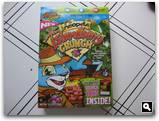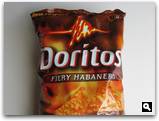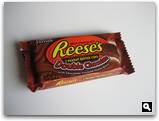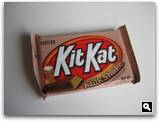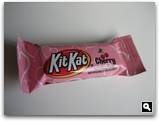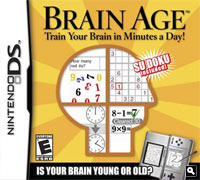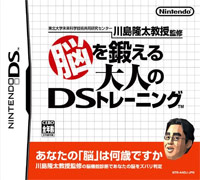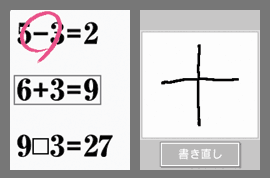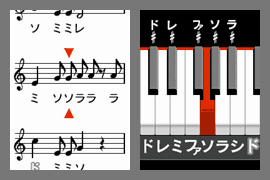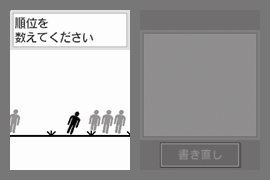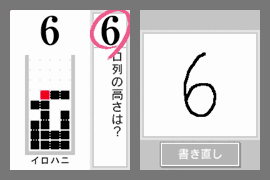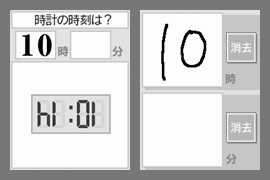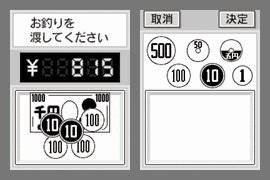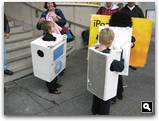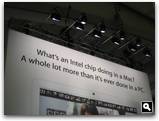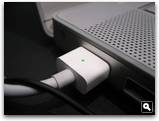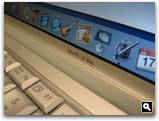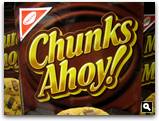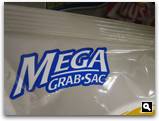Monday, January 30, 2006
If a successful weekend can be measured by discovering "New!" snack food products — and if yours can, then maybe we can form some kind of lonely support group — mine was very successful weekend, indeed. One might even say
deliciously successful! Etc etc.
One General Mills (Big G) new product can be considered a successful discovery by any measure, but three
1 new cereals at once? In Australia, they call that "drowning the manatee" — true success with no downside!
I thought you might like to see what's new in these parts. Don't be surprised if these items wind up in a future Panic TwinRate taste-off...
Tried any of these snacks? Post a comment and let me know what you thought!
Start your brains: Nintendo just announced that Brain Training is coming to the USA. It's now called
Brain Age: Train Your Brain in Minutes a Day, and
according to the press release, it drops on April 17th! Better still, the second game, now titled
Brain Flex, is scheduled for May 30th.
"Young or old, everyone looks for ways to get a mental edge," says Reggie Fils-Aime, Nintendo of America's executive vice president of sales & marketing. "Our brain-training series, led by Brain Age, builds on the popularity of word and number puzzles and acts as a treadmill for the mind."
Nintendo's brain-training series of games represent a cornerstone of Nintendo's aim to expand the world of video games to new audiences. The second title in the series, Big Brain Academy (known as Brain Flex in Japan) offers players 15 fun activities that test their brain powers in areas like logic, memory, math and analysis. Up to eight people can play with a single game card, and each activity takes less than a minute to complete.
Brain Age: Train Your Brain in Minutes a Day is rated E for Everyone and launches on April 17. Big Brain Academy is Rated E for Everyone and launches May 30.
Will it catch on like it did in Japan? Will it cause the Nintendo DS to reach a whole new generation of gamers in America? Or will it generate a million virtual crickets and digital touchscreen-tumbleweeds? It certainly doesn't hurt that Nintendo plopped a big "SU DOKU Included!" violator right on the box — now that's genius.
Tuesday, January 24, 2006
Spotted this ad in the paper. Looks like
somebody didn't watch the movie! Batten down the Best Buy returns department!
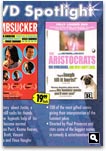
Monday, January 23, 2006
As you read this, a fairly significant revolution in the videogame industry is taking place in Japan. A quirky "game" is gaussian-blurring the line between games and applications, old and young, fun and utility, gamer and non-gamer — and you might be surprised by the results.
It tells you a lot about both the game industry, and Japan itself.
The game? Nintendo's 東北大学未来科学技術共同研究センター川島隆太教授監修 脳を鍛える大人のDSトレーニング. That's right! "Touhokudai Gaku Mirai Kagakugijutsu Kyoudoukenkyuu Center: Kahashima Ryuuta Kyouju no Nou o Kitaeru Otono DS Training".
Seriously.
You can call it
Brain Training.
Brain Training is, basically, an application — one you just happen to play on a handheld videogame system. In this case, the system is Nintendo's DS — a quirky, two-screen-with-touchscreen handheld system that's technically creakier than Sony's PSP, but which has lived up to its intended purpose of generating innovative new styles of games for a
new generation of gamers.
And what does Brain Training do? Well, you hold your Nintendo DS like a book (with left and right screens), and you basically use the touchscreen to undergo a wide variety of simple, cleanly-designed, interesting exercises intended to make you smarter. Or, at least, keep your brain sharp and fresh and delicious. At the end of your "fun", the game eventually calculates and reports your "mental age" —
often with painful/comedic effect — and tracks your progress over the weeks and months of self-education. And that's about it.
Sales Madness
It may sound painfully simple, but it's been unstoppable. From Dec 26th to January 1st, Brain Training 2 sold 414,556 copies. In one week. It has consistently been the number one videogame since its release, and — this is important to remember —
it's not even a videogame. Has it driven hardware sales? In the same period, the Nintendo DS moved 390,181 units. That's more units sold than every other hardware system that week —
combined. (Yes, that's
two dramatic
ItalicsFacts!)
Most importantly, though, Brain Training is doing what Nintendo said they would do but nobody really believed them on: opened gaming up to a whole new generation of players. Seeing grandmothers on the train holding their Nintendo DS like a book sends an instant signal — "brain training in progress".
How It All Came Together
I asked Nobuhiro "Noby" Hasegawa — President and CEO of the monolithic, sprawling Japanese entity known as Panic Japan — to elaborate on what makes it so successful.
Here's what I learned from him.
1. There's an existing brain-training boom in Japan.Dr. Kawashima, the creator of Brain Training, is leading authority in Japan on brain medicine. His research shows that:
- The brain becomes weaker every year, just as the body becomes weaker every year
- Effective training is a way to regain body strength
- The brain can also be trained, and can be rejuvenated
- The brain doesn't need difficult training: even easy work is effective, like reading a book out loud, simple calculations, etc.
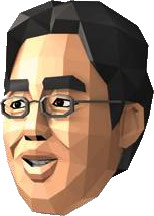
Freaky Polygon Dr.Kawashima
Hooking humans up to some presumably expensive and freakish brain-scanning equipment, Dr. Kawashima did some interesting tests. When a brain is simply "thinking", presumably about chocolate chips and where cat hair goes,
it generates this much activity. When a very difficult expression is being worked out.
looks something like this. Not a lot going on, really.
On the other hand, when very simple calculations are performed quickly,
the brain lights up like a drunk at a drunk convention. It also shows
lots of activity when sentences are simply read aloud.
With this research, Dr. Kawashima published a "training manual" for the brain, and it became incredibly popular. They were usually bought as presents from grandchildren and children for their parents and grandparents.
Is it junk science? Is there truth to it? I'd certainly love to know more, but it's already all the rage. To quote Noby: "People always want to remain young! Health and dieting are always interesting. Now, this is true with the brain as well."
2. The Japanese don't necessarily attach stigmas to "childrens" activities.In America, most adults don't read comics, or play videogames. This is, of course, changing, presumably as my generation grows older and has kids (bring it, Jack Thompson!), but it's still basically true. Games aree children's activities — not for adults.
Of course, in Japan, manga is hugely popular, and the enduring image of a expensive-suited businessman reading a thick-as-a-baby's-arm comic book on the way to his desk job is as strong as ever.
Thus, as Noby said, "the sense of resistence of the Japanese adult to Nintendo DS's Brain Training was little."
3. It's priced really well.It costs about 2,800 yen in Japan — $25 — the same price as two Brain Training textbooks. So, anyone considering a purchase of the books will likely consider the game.
4. Really, it's a fiendish trojan horse.But, the parents will need a Nintendo DS to play, right? Will an adult buy one just for Brain Training? No, and they don't need to — their children already own one. And thus, the true genius of Nintendo's trojan-horse "Touch Generations" concept is revealed.
Many parents might be reluctant to pick up a game system for their children. Noby specifically uses the (somewhat sexist but contextually-correct) example of "Game System vs. Japanese Mom", which he puts this way: "A game system is obstructive for cleaning. The controller is complicated so Mom doesn't want to try it. It gets in the way of the child's studying. Etc." In order for the game machine to succeed in the household, it'll basically need the mother's approval.
The adult only needs to borrow the game system while, say, the child is at school, furiously Brain Training while the child is, presumably, learning themselves. Before you know it, the game system is something mom uses — every day.
Noby concluded, "I expect that Nintendo developed BRAIN TRAINING as a method for obtaining the video-gaming approval of parents. And, the attempt seems to have succeeded."
Nintendo wins, and the industry grows. Tricky!
What does it all mean?
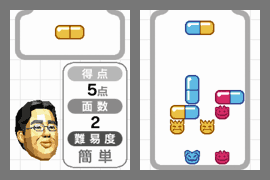
The included "Relax Mode", a.k.a. Dr. Mario
So, the #1 game in Japan is a non-game. My (shocking) conclusion: there is a huge market for new styles of games and new game players, and the gap between "games" and "apps" is getting smaller.
At first it's hard to imagine something like Brain Training ever hitting the top of the USA video game charts. Virtually impossible, I'd wager.
But, if you had told me that "Deer Hunter" would've become the top-selling computer game a few years ago, I would have pulled the car over and laughed you out of it — and yet, it happened, stunning a whole generation of developers who were working on "Brown Devil Alien Guns III"-style games.
Both successes tell a valuable lesson: there are a lot of people who could play video games, but don't, because the right software isn't there.
This is also interesting to me because we've already watched applications slowly becoming more "fun" on the Mac, a testament to simplified design and strong UI. In fact, the whole iPhilosophy seems to be taking complex tasks and boiling them down to bare but highly enjoyable essentials, creating applications that — yes — anyone can use.
Even creating a DVD in iDVD is now just as much "work" as it is "fun": setting your goal, trying different themes, experimenting with music, dragging and connecting all of the pieces together, managing available disc space, testing it all out, etc. With a certain degree of ridiculousness, I'll say this: iDVD is basically a 2D strategy game without the historical setting.
Brain Training may be the very first app hiding out as a "game", and the lines, as mentioned, will only blur further. I like this.
But most importantly, I look forward to picking up Brain Training's US release. Even if it doesn't catch on like wildfire, I look forward to training the hell out of my brain. I secretly hope it will grow to kick other brain-asses.
Tuesday, January 17, 2006
Exhausting. Fun. Painful. Inspiring. Another Macworld Expo has given us thrills and insight, then used us up and left us crushed and void, like a tattered issue of Us Weekly being read by a bindle-toting hobo — a metaphor which was at best terrible, and at worst totally inappropriate. Let me try this again: it was a totally awesome Macworld. Without worrying about selling stuff (the booth was free, thanks Apple!) we relaxed a bit more and simply enjoyed talking with existing customers and fans, gathering feedback and ideas, introducing ourselves to new potential customers, and catching up with the micromunity of Mac businessness and friends (including new friends!) who we only get to see, at most, twice a year.
Through Wednesday, the bulk of the Panic crew — that'd be Dave, Wade, Will, Ian, Mike, Les, and Tim, but no Noby because he has a baby on the way! — shared shifts and worked the booth as a team. Everybody did a great job, and the "new guys" dove in with aplomb. Thursday and Friday marked a pleasant return to "back in the day" antics — it was just Steve and I, partying like it's 1999.
You already know what was announced, and what's new. So, for your amusement, here are my random notes and pictures, Behind the Expo.
The Name. It's all been said, and I'm positive we'll get used to it. It's interesting, though, that the word "Apple"
isn't mentioned once on the MacBook Pro ad. Not once! Clearly, they're trying to build up Mac as a brand — does this relate to the number of people I hear in the mall unintentionally calling The Apple Store, "The iPod Store"? (That one always stings.)
Intel. It's here, and we're excited. And they shipped early! And there's more to come. This can only mean good things.
Equinux, Plasq, El Gato, et al. Mac developers are getting good. El Gato did an great revamp of their interface for EyeTV. Equinux is designing some really fantastic-looking user interfaces. And Plasq rocked socks on their first try with Comic Life. Nice to see hot things happening.
Tim-Tams. Speaking of Plasq, when some very nice Australians from a neighboring booth offer you famous Australian biscuits, and you love foreign snack food, and you've somehow never heard of them, and you happen to be really hungry, said biscuits officially become Best Of Show 2006. Delicious!
Rubber iMac Covers. Because my iMacs always get scratched when I carry them in my pocket. (We especially liked the white ones!)
New Apple Software Packaging. Last year's illustratiive boxes were totally gorgeous. Maybe they didn't sell? To quote Mr. Frank in regards to the
new .Mac box: "It looks like the Internet threw up."
Eudora. It must be said publicly: Aaron, at Buy Olympia/Endicia, still, after all of these years, uses it.
What a dinosaur! ;)
G5 Bling. Hooray to WiebeTech for the weird idea.
Eating, Drinking. It happens to us every time. And we love it. Then we hate it.
Jimmy Carter.Leftover Pictures. From
Bonus Resources to
Choice,
scary street matresses to
scary street plush,
donuts things to
door #1 and
door #2, and — of course! —
a little fog.And then, just like that,
the show was over.
Ten seconds later, the carpet was totally gone from the floor. A few hours later, we were home.
Wednesday, January 11, 2006
Hot and fresh from the show floor (and quickly before it gets too busy around here) here are some quick pictures of the new MacBook Pro.
Enjoy!
Macworld Nerd Update: John G. just tipped us off to the fact that Apple
announced an exchange program for Developer Transition Kit owners. If you paid your dues earlier this year to get a Developer Transition Kit machine on which to build and test Intel binaries, you probably expected to send that machine back soon and get bupkis in return. Turns out Apple will now replace that machine for a new Intel-based Mac, free of charge. You don't even have to pay shipping! MegaHooray for Apple, and thanks, John!
Macworld Meta Update: If you check out
the picture at the top of this Gizmondo post, you can see my hands on the left taking the very close-up picture of the power connector you can view above. Now that's Internet Trippy!
Thursday, January 05, 2006
As part of our
Apple Design Award prize last year (hooray,
Transmit team!), we've been given a small kiosk at this year's
Macworld Expo San Francisco.
While our general rule is to never exhibit two years in a row — it's not only expensive, but exhausting! — we're not about to turn
up down a free booth. The entire crew will be down until Wednesday, and Steve and I will be staying until Friday. Hopefully, it'll be mellow, just hanging out with our award-winning peeps, chilling next to the Gaming Zone (?), answering your questions about Transmit and stuff and, yes, showing a sneak peek of the next update to Transmit.
Yes, we'll also have a (small) handful of shirts to give away. Just stop by and say hello.
MWSF, Booth #2407, all the way on the right. See you there.
After a few months of having an Xbox 360, last week it kicked the proverbial white-and-chrome "inhaling" bucket.
Of course, Microsoft hand-crafted my particular error message for maximum comedic value. See for yourself:
Yes. Every time I put an Xbox 360 game in my Xbox 360, a message comes up: "Please put this disc in an Xbox 360."
1The yay: I shipped out my Xbox 360, they got it on Tuesday, and I got a completely brand new one on Thursday.
The boo: as my Xbox 360 was completely replaced, so was the hard drive, thus losing all of my save games and plunging me into a "do I really want to re-play that?" zone of anguish. Why invent snap-off hard drives if you don't, y'know, snap them off? "Oh, somebody really should have told you to keep the hard drive," noted Microsoft support. Yes — yes.
So, hooray for Microsoft and Microsoft sucks, simultaneously, as always. (And, at least, thanks for the error
roflcopter.)
Sunday, January 01, 2006
Last week, while eating a bag of chips, I was surprised to find that it had a blog. I can't say it was a particularly good blog ("Current Mood: Maltodextrin ^_^"), but it made me realize that I'm way, way late for my personal trip to Blog Town. It's 2006, and here I am.
Hi, I'm Cabel. I'm the co-founder of
Panic (a Mac software company), and my friend
Steve has had a blog forever.
First blog step: secure a hot, hot "internet domain". With most of the obvious ones long since taken, and after rejecting the extremely tempting "cabelog.com", I thought I might as well be the sixth person in all time to register a ".name" domain. It seemed perfect and beautifully awkward — with a name like Cabel — to grab cabel.name. (And no, I did not consider www.cabel.tv. And yes, I have heard that before —
like, only a million trillion times.)Next blog step: the design. This was fun. Blogger is easy. I did some interface exercises. For example, I wanted to try to improve the way previous links are presented on blogs (do they have to be always visible?), and so I came up with a pop-up floater (click "Previous Entries" at the top). I hope it's an improvement. (Let me know.)
Final stop: photos. I plan to post pictures up in here, but I've never been totally happy with how to present full-size images on the web. Usually, at least on the Panic site, I simply have them pop open in a new browser window, but I really hate introducing a whole new window just for a zoomed-up view.
So what's my new idea? Well, for example, I write, "Hey, here are some amusing pics from Canada", and then you click:
Meanmo! How about that. Cool? Lame? Looks weird? Too slow? Let me know. (I'm still working out pre-loading issues, and don't be surprised if this idea works its way into Panic-y things.)
All that's left now is — oh goodness — writing about stuff.
Here's my topic prediction: interesting Panic happenings, the Mac (or, as I said when I was about three years old, "Compooters and Ewectwonics"), design (graphic, interface, real-world), games, snacks, etc. Basically, Cabel stuff. (I'll try to keep it away from the mundane personal observations, for example I only just discovered this weekend that cinnamon toast is just as delicious —
if not more delicious — when you
don't toast it. Yes: mind blowing.)
Anyhow, thanks for visiting, let me know if there's any stories you'd like me to tell or topics you'd like me to cover, and please e-mail me if I never post again. Awesome. See you in 2007!
© 2009 Cabel Sasser


